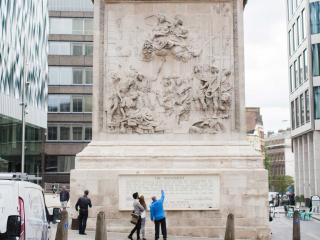Sir Christopher Wren is best known for designing The Monument to the Great Fire of London and St Paul’s Cathedral. Discover more about his life and his other achievements as England's most acclaimed architect.
The man behind The Monument
The man behind The Monument
Sir Christopher Wren is best known for designing The Monument to the Great Fire of London and St Paul’s Cathedral. Discover more about his life and his other achievements as England's most acclaimed architect.
Sir Christopher Wren was an English scientist and mathematician, as well as being one of the most distinguished and significant architects in the country. He is best known for designing many of the new buildings in the City of London following the devastation caused by the Great Fire of London in 1666, including The Monument and St Paul’s Cathedral.
Christopher Wren was born on 20 October 1632 in East Knoyle, Wiltshire. His parents were Mary Cox and Christopher Wren Sr, who was rector and then later Dean of Windsor. Christopher Wren was their only surviving son and, despite being described as a sickly child, he would survive into robust old age.
Portrait of Sir Christopher Wren © London Metropolitan Archives. The London Picture Archive, ref. 291869.
Wren was educated at Westminster School from 1641 to 1646. In 1650, Wren entered Wadham College, in Oxford, to read Latin and the works of Aristotle, which extended into studies of science and mathematics. During his time at Oxford, he made acquaintances with many key mathematicians, creative workers, philosophers and scientists who eventually formed the Royal Society, which received its Royal Charter from Charles II in 1662. In addition to being one of the founding members, Wren was president of the Royal Society from 1680 to 1682.
Wren’s scientific works ranged from astronomy, optics, cosmology, mechanics, microscopy, surveying, medicine and meteorology. He also invented and improved a variety of instruments.
In 1663, Wren designed a chapel at Pembroke College, Cambridge, and submitted a model of his design of the Sheldonian Theatre in Oxford. These were the first of his designs to include a dome; from that point on, architecture became his main focus.
Around 1665, Wren began studying architecture in Paris. There, he discovered the work of Italian sculptor and architect Gian Lorenzo Bernini, who was visiting France at the time as a guest of King Louis XIV. Bernini then became a great influence to Wren.
Once Wren returned to London, he started sketching his first design for St Paul’s Cathedral, which before the Great Fire was not in the best condition. A week later, on Sunday 2 September 1666, the Great Fire broke out at a bakery in Pudding Lane.
The Great Fire of London lasted four days and destroyed two-thirds of the City of London.
In the aftermath of the fire, Wren was appointed Commissioner for rebuilding the City of London with help from surveyors, including Dr Robert Hooke. Wren produced ambitious plans to rebuild the entire area, but they were mostly rejected as property owners insisted on keeping the sites of their destroyed buildings.
However, Wren designed and built 50 new churches, including St Paul’s Cathedral, St Dunstan in the East and St Margaret Pattens, and The Monument. He was knighted on 14 November 1673, both in services to the Crown and in playing an important part in rebuilding London after the Great Fire.
Image: St Margaret Pattens by G.R. Clarke © London Metropolitan Archives (City of London). The London Picture Archive, ref. 8021148.
Christopher Wren and Dr Robert Hooke created the final design for The Monument to the Great Fire of London. Its construction began in 1671.
The Monument was built to serve as a permanent reminder of The Great Fire of London, commemorating one of the most significant events in London’s history and celebrating the City that rose from the ashes.
It took six years to finish, partly due to the difficulty of obtaining enough Portland stone required and partly due to the safety of its transport as the country was at war with the Dutch (again!) between 1672 and 1674. The Monument was finally completed and opened in 1677.
Wren had many notable achievements, mostly in architecture. Dr Robert Hooke, co-designer of The Monument, said of him: ‘since the time of Archimedes there scarce ever met in one man in so great perfection such a mechanical hand and so philosophical mind’.
Whilst Wren will be remembered most for the design of St Paul’s Cathedral and The Monument, his many other significant works include the Royal Observatory in Greenwich, Trinity College Library in Cambridge and the façade of Hampton Court Palace.
Image: Royal Observatory Greenwich © National Maritime Museum
Wren took trips into London regularly to visit his architectural achievements, and had a house in London, as well as his family home at Hampton Court. At the age of 90, he caught a ‘chill’ on one of these visits, which he never recovered from. He died on 25 February 1723, and was laid to rest in the southeast corner of the crypt of St Paul’s beside his daughter Jane, his sister Susan, and her husband, Dr William Holder.
The plain stone plaque attached to his crypt was written in Latin by Wren’s eldest son and heir, Christopher Wren Jr, and reads: ‘Here in its foundations lies the architect of this church and city, Christopher Wren, who lived beyond ninety years, not for his own profit but for the public good. Reader, if you seek his monument – look around you. Died 25 Feb. 1723, age 91’.



Please note that The Monument is closed to visitors today, Friday 31st October. We apologise for any inconvenience caused.